Astrometric Anomalies of Supernova 2006gy
Formerly SN 2006gy as a Possible Ritzian System
Robert Fritzius
Shade Tree Physics
This page was extracted from
De Sitter's Whimsical Images on 06 Jun 2007.
Latest Update 22 Feb 2014. New or revised material is in bold.
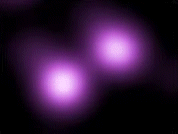
Supernova 2006gy
Chandra X-Ray / Lick IR
Credit: Illustration: NASA/CXC/M. Weiss: X-ray: NASA/CXC/
UC Berkeley/N. Smith et al.; IR: Lick/UC Berkeley/J. Bloom & C. Hansen
Quoting from the Chandra Chronicles 07 May 2007.
"SN 2006gy was first detected by an optical robotic telescope as part of
the Texas Supernova Search project on September 18, 2006. It brightened
slowly for about 70 days, peaked at a luminosity or intrinsic brightness
equal to that of 50 billion suns - ten times brighter than its host
galaxy - and began a slow decline."
...
"The Chandra data, taken 56 days after the explosion of SN 2006gy, revealed that SN 2006gy was a relatively paltry X-ray emitter. Although a collision of the supernova debris with the surrounding cloud is occurring, the cloud is not dense enough to explain the optical brilliance of the supernova. The weak X-ray emission also rules out any type of gamma-ray burst event."
SN 2006gy Astrometry
(0) When SN 2006gy was first detected on 18 Sep 2006, its approximate position was given as 2" west and 0" north from the center of NGC 1260. (Source?)
(1) The offset listed on 24 Sep 2006, was 2".0 west +0".4 north
(2) On 26 Sep 2006 Prieto et al reported that the SN's position was consistent with being at the center of NGC 1260, and that that position was more consistent with an erruption of an active galaxy nucleus, i.e. NCG 1260.
(3) On about 27 Oct 2006 Foley et al reported that the SN was offset by about 1" from the nucleus of NGC 1260.
(4) On 01 Nov 2006 Ofek, et al reported, "Our adaptive optics (AO) images (Fig. 3) show that SN 2006gy is located 0.99" ... at a position angle of 290 degrees [CCW from North] from the nucleus of NGC 1260.
(5) On 04 Nov 2006, The Lick IR image shows the SN when it was located at 0".941W and 0".363N, 1 σ = 0".01 for both measurements from the nucleus. This cartesian position is equivalent to 1.01" at 291 degrees [CCW from North].
The following graph shows the reported positions (0) through (5) for SN 2006gy, along with their uncertainties.
I have drawn in a hypothetical path (in blue) for the star which produced SN 2006gy, and show the very non-intuitive ordering of the star's locations, based on Ritzian relativity arrival time modulation. These are labeled A through D.
Ritzian position D would be located to the southeast of the center of NGC 1260. I have not seen a report which impacts favorably, or otherwise, on an image in that location. (This "southeast" position, may be considered as an experimentum crucis in the case of SN 2006gy.)
The (closest point of approach) position for a second star (necessary for the Ritzian time reversal sequence) has been added to the drawing.
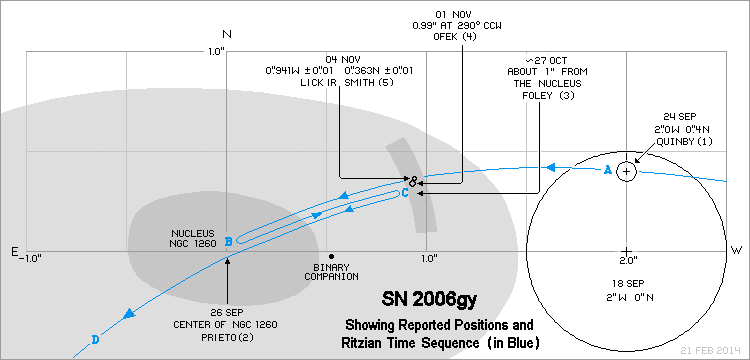
Reported positions (with 1σ uncertainties) for SN 2006gy
The following drawing shows computed times of arrival (based on Ritzian relativity) for light pulses reaching us from two stars which have passed close enough to one another to cause gravitationally induced velocity changes. It is shown to illustrate Ritzian arrival time aberrations where large distances between sources and observer are involved. For the blue star, between points B and C the arrival times are occurring in reverse time. I claim that points A, B and C are in consonnance with the disparate position reports for SN 2006gy. Point D, as mentioned above, is currently in limbo. (Related animations are given further down in the article.)
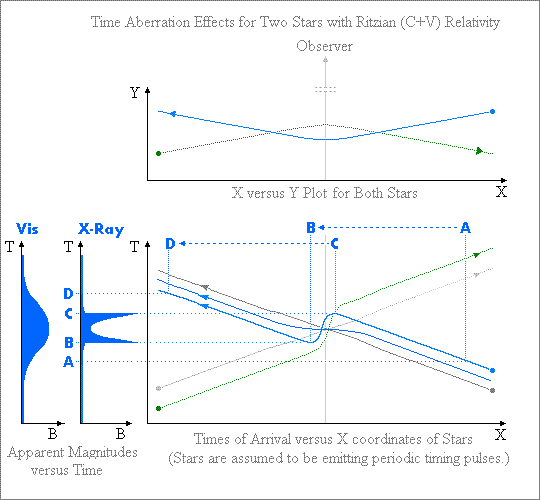
SN 2006gy is generally thought to be located near to NGC 1260, some 240 million light years from us. If the 27 Oct 2006 position(3) was in fact about one arcsecond to the East of the 24 Sep 2006 position(1), then the distance to NGC 1260 would lead us to the conlusion that SN 2006 had been traveling at an average speed of approximately 18,000 times the speed of light (eastward) during those 23 days.
Adriaan van Maanen would say that SN 2006gy is probably very much closer to us than big universe proponents would have us believe.
Here's a gif animation of a binary star encounter (based on Microsoft Excel c + v computations) which shows the non-intuitive arrival time modulation, and hence apparently strange motions in the night. The grey dots represent where each star actually was and the red dots show where they seemed to be to an observer located (in this case) at approximately 20 lightseconds to the right of the binary centroid.
Note that star A's apparent positions (the red dots) jump to a post-perihelion region immediately prior to actual perihelion passage, and then, following actual perihelion passage, they very briefly jump back to a pre-perihelion region. Again, this jump back is in consonnance with the apparent motion between points B to C in the SN 2006gy positions diagram above.
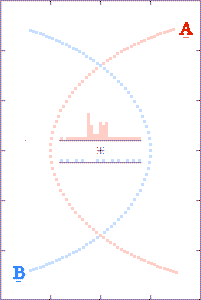
Apparent versus Actual Binary Star Positions
V(perihelion)=0.6c - Major axis diameter=1.0 Light Second (LS)
Binary Orbit period = 81 seconds. No extinction.
Observer is located 20 LS to the right of the binary centroid.
The model employed here is based on the idea that the observer's distance from the binary is the same as the dispersive extinction distance, where the absorbed and re-radiated light (whether faster or slower than the standard value for c has become normalized to c. From that point on, it travels at c with respect to the dispersive medium.
For animations for other observer distances from the binary, and for more information on what the Ritzian model is portraying, see Highly Elliptical Path Ritzian Variable Star Animations
Ritzian Relativity and Apparent Supernovae
(This section is in a state of constant re-write.)
The jumps forward and backward are in accordance with Ritzian relativity, i.e. the faster later (post perihelion) light overtaking and passing slower earlier (pre-perihelion) light. The jump-forward and back may explain Prieto's seemingly inexplicable report(2), early in the game, that the SN was "consistent with the center of NGC 1260.
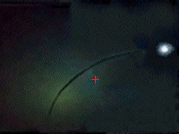
Hypothetical Ritzian Binary Sequence
Credit, original images, as above.
According to Ritzian relativity (See page 150 in the Introduction.), the velocity of a source is additive to the velocity of its emitted light. When a star, which is considered to be subject to Ritzian relativity, is executing a parabolic or hyperbolic arc around behind another star, as it is approaching the other star, and traveling away from us, c-v effects slow down it's light that is emitted in our direction. Later on, as it begins its outbound trek, c+v effects speed up it's light emitted in our direction. This faster-later light has a tendency to catch up with the slower-earlier light. The effect of these actions should be much more pronounced for X-rays than for visible or longer wavelength light because, according to J.G. Fox (6), the shorter the wavelength, the greater the extinction distance. (The extinction process normalizes light speed that is different from c, to the speed of light with respect to the medium through which it is traveling.) Even though the original light becomes extinct in this process, the re-emitted light preserves the Ritzian brightness and frequency variations.
At longer wavelengths, such as in IR, the star that gave us SN 2006gy would tend to appear as a continuously moving singlet with a supernova-like light curve.
If the angular resolution of the viewing system is good enough, Chandra, in this case, then the star's X-ray image can be seen as simultaneous flashes at two different places (inbound and outbound) along the star's track.
For more on the theory behind this speculative binary star scenario, see A Ritzian Interpretation of Variable Stars.
In frame 3, the alignment of the left-hand X-Ray lobe and the nucleus of NGC 1260 is, until compelling evidence leads elsewhere, considered by this author to be a chance alignment.
The Double-Lobed X-ray Flash
What follows goes against the adage about not asking questions to which you don't know the answers.
In the "double lobe" X-ray image of SN 2006gy, the lower-left lobe has been identified as the nucleus of NGC1260. SN 2006gy has been identified as the upper-right lobe.

SIMBAD does not list NGC 1260 as an X-ray source. (Query Identifier "ngc 1260". Then, in the "Plots and Images" section, click on "plot around." When the map pops up, X-ray objects will be shown with "x" symbols. NGC 1260 is not so labeled.)
Now that the luminosity of the supernova has declined, is the X-ray region which coincided with the nucleus of NGC 1260 still as luminous as in the Chandra SN 2006gy image?
If the answer to the preceding question is "no" then the lobe must have been a manifestation of SN 2006gy, and therefore is subject to being interpreted as a piece evidence in favor of Ritzian relativity. If the answer is "yes" then I'll have to think seriously of re-writing (or pulling) this web page.
References
(Central Bureau for Astronomical Telegrams)
(1) Quinby, R. 24 Sep 2006, CBET 644, 1
(2) Prieto, J.L. et al., 26 Sep 2006, CBET 648, 1
(3) Foley, R.J. et al., Apx 27 Oct 2006, CBET 695, 1
(4) Ofek, E.O., et al., The Astrophysical Journal, 659: L13-L16, April 10, 2007.
(5) Smith, N., et al., arXiv:astro-ph/061267v3 22 May 2007
(6) Fox, J.G., Am J. Phys. 33, 1, 16 (1965)